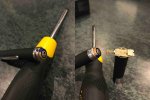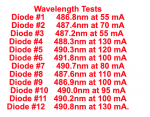Hello everyone,
I'm new, and I'm very glad to have found this resource. Quick notice: I am not very well versed in electronics, but I do understand the fundamental concepts enough that I thought I could get by (we'll see), and I did try to study youtube tutorials as well as other beginner threads. If I could get any input from anyone for a basic (I think) project, I would really appreciate any help.
*I did invest in protective eyewear prior to starting this project.
For my first project I wanted to assemble a 55mW 488nm pointer, not really building it from scratch as most of it is already assembled. Nothing crazy powerful, although I am well aware of the damage it can cause. I just like the color, and the only practical purpose I want to use it for is stargazing. As I stated before, I am a beginner, but I think it will be gratifying when I am able to finally assemble a laser that works.
Materials:
- Sharp 488nm GH04850B2G 55mW Laser Diode (DTR)
- ACS1500SE 1.5A Buck/Boost Driver (DTR)
- DTR-G-2 Glass Lens W/Focus Ring
- 12mm Copper Module, Full Length, for a 5.6mm laser diode
- Cheap laser housing from a previous mass production laser.
Additional Materials:
- Multimeter
- Soldering Kit
Now for the fun part/ the problem.
I actually purchased the fully assembled 488nm diode module from DTR, so we can safely assume that it was wired correctly and the correct driver was used. This is in part because I was not sure which driver to use with the 488nm 55mW diode, and figured that DTR would use an ideal option. I think I would have attempted building it from individual components if I had known what driver to use.
Anyways, I used the multimeter to try to ensure that I wasn't going to "fry the diode" as I have read so much about already. So, I took two AAA batteries, loaded them into the cheap housing, and measured its voltage and current. (This is probably where it starts to sound cringe-worthy, I really tried to understand it but I'm sure this is where I'm messing up). Current read out around 3.52 Amps or so, and about 2.92 Volts.
I attached the wires from the pre-assembled module to the respective (+) and (-) parts of the housing with batteries, saw a beautiful 488nm color for about 0.2 seconds, and worst of all, I could hear a quiet, high-pitched sound coming from the module right as it flashed the blue light, before it seemed to burn out.
The Driver says it can handle input voltage of 2.9-12V if I'm not mistaken there. Driver output seems to be between 0-1500mA. As I understand it, the driver modifies the input to ensure that the current doesn't exceed 1500mA and overpower the laser diode.
So, is the issue that too many amps were going into the driver? It seems like every youtube video shows someone loading their DIY laser module into either a AAAx2 or AAx2 housing assembly and then proceed to ignite various objects, so I figured I would have been fine, but I was probably foolish to rush into it like that.
If the diode is fried, at least I can try my hand at soldering a new one onto the driver for $30. That sucks, but not the worst price to pay for a learning experience. But on my second go around, I'd really like to get this right, so if anyone is able to help me figure this out, I would really appreciate it.
Thank you!
I'm new, and I'm very glad to have found this resource. Quick notice: I am not very well versed in electronics, but I do understand the fundamental concepts enough that I thought I could get by (we'll see), and I did try to study youtube tutorials as well as other beginner threads. If I could get any input from anyone for a basic (I think) project, I would really appreciate any help.
*I did invest in protective eyewear prior to starting this project.
For my first project I wanted to assemble a 55mW 488nm pointer, not really building it from scratch as most of it is already assembled. Nothing crazy powerful, although I am well aware of the damage it can cause. I just like the color, and the only practical purpose I want to use it for is stargazing. As I stated before, I am a beginner, but I think it will be gratifying when I am able to finally assemble a laser that works.
Materials:
- Sharp 488nm GH04850B2G 55mW Laser Diode (DTR)
- ACS1500SE 1.5A Buck/Boost Driver (DTR)
- DTR-G-2 Glass Lens W/Focus Ring
- 12mm Copper Module, Full Length, for a 5.6mm laser diode
- Cheap laser housing from a previous mass production laser.
Additional Materials:
- Multimeter
- Soldering Kit
Now for the fun part/ the problem.
I actually purchased the fully assembled 488nm diode module from DTR, so we can safely assume that it was wired correctly and the correct driver was used. This is in part because I was not sure which driver to use with the 488nm 55mW diode, and figured that DTR would use an ideal option. I think I would have attempted building it from individual components if I had known what driver to use.
Anyways, I used the multimeter to try to ensure that I wasn't going to "fry the diode" as I have read so much about already. So, I took two AAA batteries, loaded them into the cheap housing, and measured its voltage and current. (This is probably where it starts to sound cringe-worthy, I really tried to understand it but I'm sure this is where I'm messing up). Current read out around 3.52 Amps or so, and about 2.92 Volts.
I attached the wires from the pre-assembled module to the respective (+) and (-) parts of the housing with batteries, saw a beautiful 488nm color for about 0.2 seconds, and worst of all, I could hear a quiet, high-pitched sound coming from the module right as it flashed the blue light, before it seemed to burn out.
The Driver says it can handle input voltage of 2.9-12V if I'm not mistaken there. Driver output seems to be between 0-1500mA. As I understand it, the driver modifies the input to ensure that the current doesn't exceed 1500mA and overpower the laser diode.
So, is the issue that too many amps were going into the driver? It seems like every youtube video shows someone loading their DIY laser module into either a AAAx2 or AAx2 housing assembly and then proceed to ignite various objects, so I figured I would have been fine, but I was probably foolish to rush into it like that.
If the diode is fried, at least I can try my hand at soldering a new one onto the driver for $30. That sucks, but not the worst price to pay for a learning experience. But on my second go around, I'd really like to get this right, so if anyone is able to help me figure this out, I would really appreciate it.
Thank you!
Last edited:





